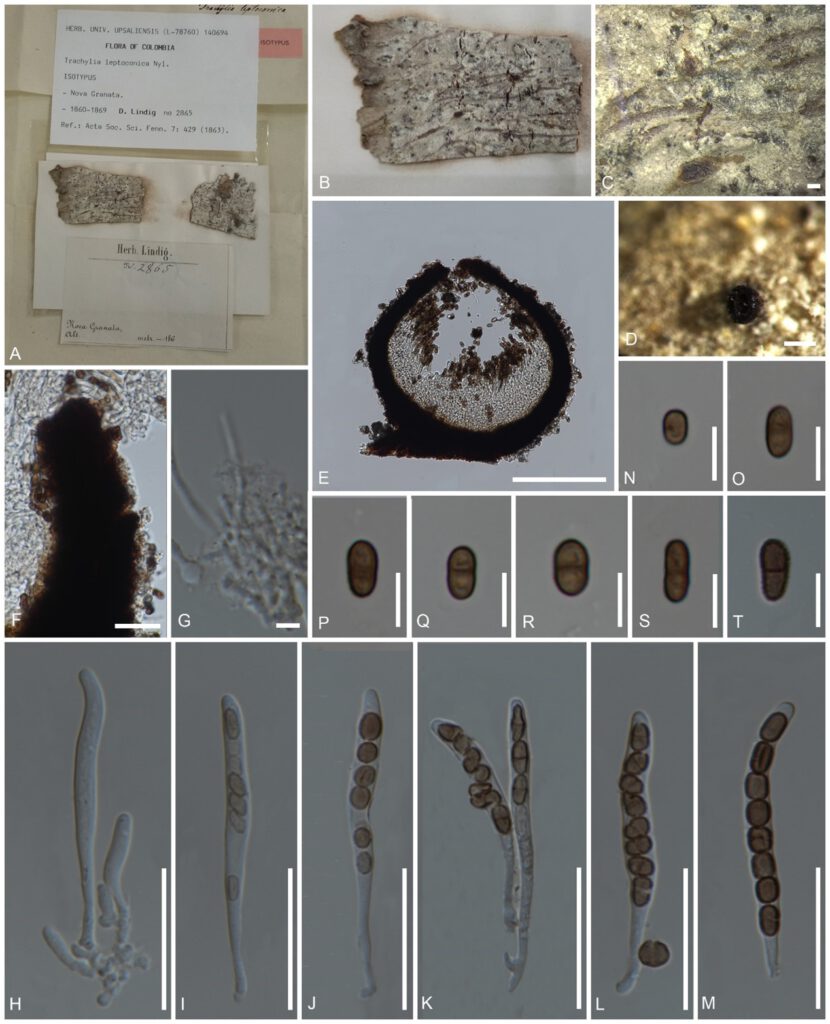Pyrgidium leptoconium (Nyl.) Nádv., Stud. Bot. Čechoslov. 5: 125 (1942) (Fig. 3)
MycoBank number: MB 369854; Index Fungorum number: IF 369854; Facesoffungi number: FoF 10276;
Saprobic on bark. Thallus crustose, farinose. Prothallus absent. Photobiont absent. Sexual morph: Ascomata apothecial, 225–230 μm diam., 230–240 μm high, not stalked, mazaedioid, disc black, sessile, scattered, almost spherical. Excipulum 10–50 μm thick, brown to black, prosoplectenchymatous, hardly comprised sclerotized hyphae, thickened basally and gradually becoming thinner towards the upper. Paraphyses 1.2–2 μm thick, septate, branched. Asci 35–43 × 3.2–5 μm (x̄ = 39 × 4.1 μm, n = 30), cylindrical, 8-spored, unitunicate, tip blunted, tholus lacking, apical apparatus inconspicuous, long pedicellate. Ascospores 4.7–7.9 × 2.2–4 μm (x̄ = 6.35 × 3.1 μm, n = 40), ellipsoidal, uniseriate, not overlapping, light brown to brown, 0-1-septate, septum slightly dark brown, gattulates at immature, verrucose, irregular ridges longitudinally arranged (Fig. 6; D–F). Asexual morph: undetermined.
Material examined: Colombia (Colombia), Nova Granata, Fusagasuga, Lindig. A, (Lindig no. 2865, UPS-Isotype).
Notes: Pyrgidium leptoconium was originally introduced as Trachylia leptoconia within Caliciaceae (Tibell 1982). This species mainly differs from the extant species of Pyrgidium in the larger asci (up to 45 μm) and uniseriate ascospores whereas overlapping bi-seriate ascospores were commonly recorded in Pyrgidium. Nadvornik (1942) stated the presence of Trentepohlia photobiont in the original material but is absent in the isotype material examined here. Aseptate ascospores are commonly observed in this species which disagreed with the original description of P. leptoconium.

Figure 3. Pyrgidium leptoconium (Lindig no. 2865, Isotype) A–D, Ascomata on substrate. E Vertical section through Ascoma. F Vertical section through Exciple. G Paraphyses. H–M Asci. N–T Ascospores. Scale bars: C = 500 μm, D = 200 μm, E = 100 μm, F = 10 μm, G = 5 μm, H–M = 30 μm, N–T = 5 μm.
